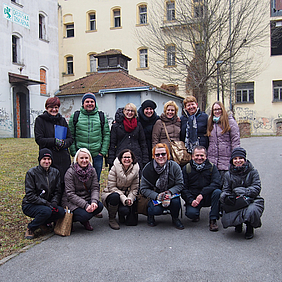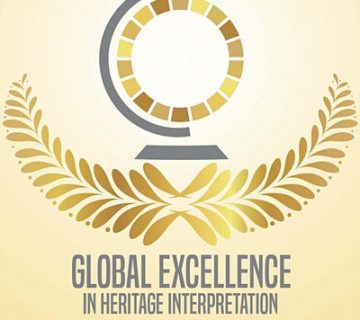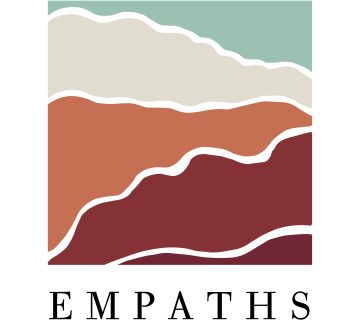Inventive interpretive talks, new perspective and skills, a very heterogenic group and memories of bitter cold winter are reasons I will never forget my first CIG course as a trainer
I have just finished my first CIG course held in Maribor, Slovenia between 27th and 29th January and 11th and 12th February 2017. I partnered up with Maribor development agency in promoting and organising this course for all sorts of professionals; tourist guides, trainers, people who work in education, project managers, and pedagogical staff. We were especially pleased with the attendance from the natural and cultural heritage sector. A wide range of knowledge and personalities with different professional backgrounds made our course richer, full of lively debates and analytical thinking. CIG broadens the horizon, offers a different approach to guiding and tests theory in practice. This quote from Nina Buh, a tourist guide at Spa Zreče, gives a good summary:
‘Learning and socialising with other participants, who all come from their different professional fields, gives me breadth of knowledge. Breadth in a sense of thinking about facts and how to give them, when viewed from different angles, different meanings. And how to use facts and meanings to approach different individuals in a group.’ (Translated by J. Sivec)
The structure of the course with some theory and a lot of practice proved, once again, to be a winning combination. Daily flashbacks proved that putting in practice what they heard in theory was one of the bigger differences of this course compared to others and what makes it so successful.
Anita Å pilak Benko, a guide at The adventure park Vulkanija, said this: ‘The course surpassed my expectations. I liked exercises, that we did not only learn in theory but we put the knowledge in practice. I liked that we had to react very quickly in given situation and did not have a lot of time to prepare and analyse what to do. We had to react immediately, something I have to do daily at my work. I am already trying to implement gained knowledge into my work and I am sure that this course was good for me. I would recommend the course to all who work in tourism, because they will start to see phenomena from different perspective and be better aware that in tourism you have to be very flexible, finding new solutions, being informed and educated on daily bases.’ (Translated by J. Sivec)
Participants recognised some parts of the program as something they already use. Either using methods and tools knowingly or, more often unknowingly, more on a hunch. But knowing about something is totally different to strategically using it in interpretive talks.
As a mentor, it helped me enormously that I did the whole process as a candidate for becoming a CIG trainer. I was once faced with the same issues and thought processes as the participants on this course – when you think you’ve got it, but then somebody shifts your point of view and you are lost.
Barbara Izlakar, a local guide for Maribor, said this of her experience on the course: ‘A new approach to guiding, that goes ‘backwards’. At classic guiding you usually tell beforehand what you are going to talk about and then you continue with detail information, guiding is not usually supported by theme, it is set of facts. Because of that I asked myself, from the beginning of the course, on how to incorporate all this in my usual guiding. /â¦/ I am not sure of what kind of guiding I will be doing in future, but if I will continue as now, I will be able to use this in a segment or two. Some elements I already use (like different props, methods), some questions, but as mentioned above there is usually not enough time or is guiding thematically to broad.’ (Translated by J. Sivec)
Mentoring this course was a big challenge for me. For the first time, leading different workshops and training, I was faced with such a wide and heterogenic group of participants, who had such different professional backgrounds and needs. Reservations about being able to mentor participants from the nature protection sector or professional tourist guides soon came to rest. Because interpretive guide standards work with interpreting natural and cultural heritage, intangible and nontangible heritage. This was proven by my excellent, motivated, active, analytical, innovative participants, who showed a lot of resilience and inventiveness with less than optimal work conditions in the field. But together we did it! Their words on how they are going to use these new skills in their work are most important to me. I think that is the point of lifelong learning and what I am trying to do as a mentor.
Janja Sivec is a Slovenian ethnographer, CIG Trainer, a member of the IE social media team, leader of NGO Legends and an apprentice in motherhood for the last 18 months. Her second favourite topic is youth work, which she does in different heritage sites. She hates writing reports and working with numbers, but it comes with leading an NGO. You can learn more about her and NGO Legends at: www.dlegende.com or contact her at: info@dlegende.com
To cite this article:
Janja Sivec (2017) ‘The first Certified Interpretive Guide (CIG) course in Slovenia’. In Interpret Europe Newsletter 1-2017, 14
Available online:
https://www.interpret-europe.net/fileadmin/Documents/publications/Newsletters/ie-newsletter_2017-1_spring.pdf




